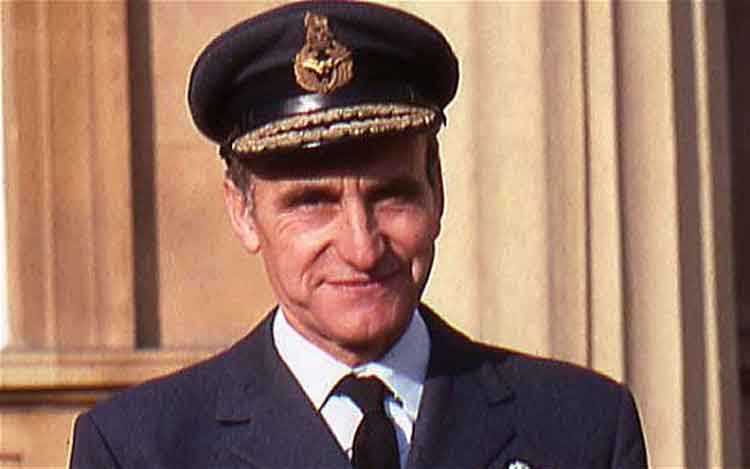Air Commodore Arthur Strudwick, who has died aged 92, spent much of his RAF service as a fighter pilot, initially flying Spitfires in north-west Europe and later piloting the supersonic Lightning as commander of one of the RAF's main fighter bases.

After completing his flying training in December 1941, Strudwick joined No 602 (City of Glasgow) Squadron. He spent an unusually long period with the squadron (almost 18 months), rising from the most junior sergeant pilot to one of the flight commanders.
No 602 was based at Kenley in Surrey, and Strudwick flew on many sweeps over France and on bomber escort sorties to targets in the Pas de Calais. After the squadron relocated to Cornwall, he led a number of missions to the Brest Peninsula, again escorting bomber formations.
He also led small formations, flying at very low level, to strafe road transports and defence positions. In February 1943 he was returning over the Channel when he noticed that his engine was overheating. Since he had encountered no anti-aircraft fire and his aircraft appeared undamaged, he was mystified; it was only after he had landed that the ground crew pointed out that fragments of French evergreen trees and shrubs had become lodged in the Spitfire's radiator and oil cooler.
In March the same year, the squadron was operating from Kent, and over Dunkirk, Strudwick's aircraft was badly damaged when a shell burst under the port wing, making his Spitfire very difficult to control. He managed to struggle back to England , making three unsuccessful attempts to land as the fighter became almost uncontrollable at slow speed.
By now short of fuel, he made one final attempt and managed to crash-land the aircraft. The port undercarriage collapsed and the Spitfire cart wheeled. Strudwick was unhurt, but his aircraft was a write-off.
Strudwick led the squadron on numerous occasions and shot down a Focke-Wulf 190 over Calais (and probably a second). On June 15 he was providing close escort to a bomber squadron attacking Poix when a large force of enemy fighters attacked his formation. During a furious five-minute engagement, four Spitfires were lost - including Strudwick's. He managed to bail out but was soon captured, and spent the rest of the war in Stalag Luft III.
Since Strudwick was incarcerated in the Centre compound, next to the German compound, escape was virtually impossible. (The Great Escape was from the North compound.) In January 1945 the camp was vacated at very short notice as Soviet forces approached from the east, and many PoWs perished on the Long March. Strudwick and a companion escaped from the column, but the winter weather was too severe to continue alone in hostile territory and they rejoined the march. Strudwick was repatriated in May 1945, soon hearing that his exploits with No 602 had earned him a DFC.
Arthur Sidney Ronald Strudwick was born on April 16 1921 at Woking, Surrey, and attended the Guildford Technical College before enlisting in the RAF in June 1940.
Following his return from Germany, Strudwick spent three years on squadrons flying the RAF's first jet fighter, the Meteor, in Britain and in Germany. In May 1948 he left for Canada to join the Winter Experimental Establishment to conduct trials in Arctic conditions of a range of British and American military aircraft. He then spent a period as adjutant of No 3510 (County of Inverness) Fighter Control Unit before he was appointed to command No 12 Joint Services Trial Unit to test the early generation of air-to-air defence missiles.
After setting up the unit in England he left for Woomera in Australia, spending two years testing the Blue Jay missile, which entered RAF service as the Firestreak, the first effective British air-to-air missile. A later version of the missile was developed and became the Red Top, which equipped RAF's Lightning and Fleet Air Arm's Sea Vixen fighters.
On his return he spent two years on the Joint Services Planning staff at the MoD; he was then promoted to group captain and posted to the Far East Air Force HQ in Singapore as Director of Air Plans Far East.
In 1965 Strudwick converted to the Javelin night fighter and the Lightning before taking command of RAF Leuchars in Fife, one of the RAF's main fighter bases. Among its tasks was keeping aircraft at immediate readiness to intercept Soviet aircraft that occasionally tried to enter United Kingdom airspace.
Promotion to air commodore in 1967 put Strudwick in charge of the Navy/Army/RAF planning staff, serving the three Commanders-in-Chief in the UK. He graduated from the Royal College of Defence Studies in 1969, and from 1970 to 1973 was Director of Flying (Research & Development) at the MoD Procurement Executive.
Until his retirement from the Service in 1976, when he was appointed CB, Strudwick was the Air Officer Commanding for the Central Tactics and Trials Organisation (CTTO). This was a recently established organisation, with the task of conducting and coordinating a series of trials to support the new generation of high-performance combat aircraft that had recently entered service with the RAF.
From 1976 until 1986 Strudwick worked at Shoreham, West Sussex, for Singer Link Miles, the flight simulator manufacturer, as a defence liaison officer.
Arthur Strudwick married, in 1941, Cissie Steadman; she died in 1983, and he is survived by their two sons and one daughter.
(Thanks to the Daily Telegraph).
